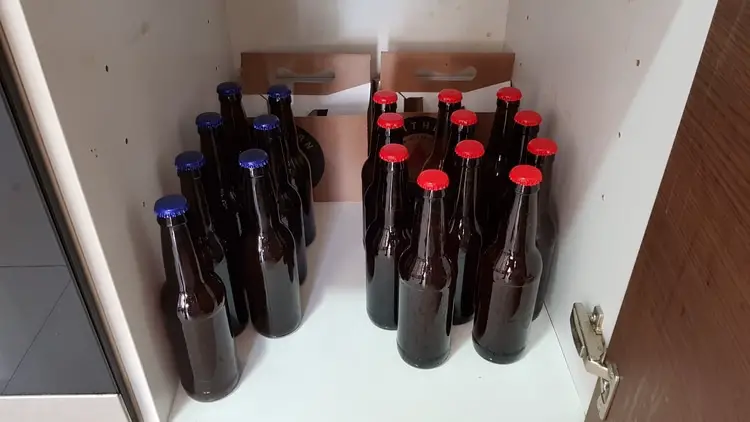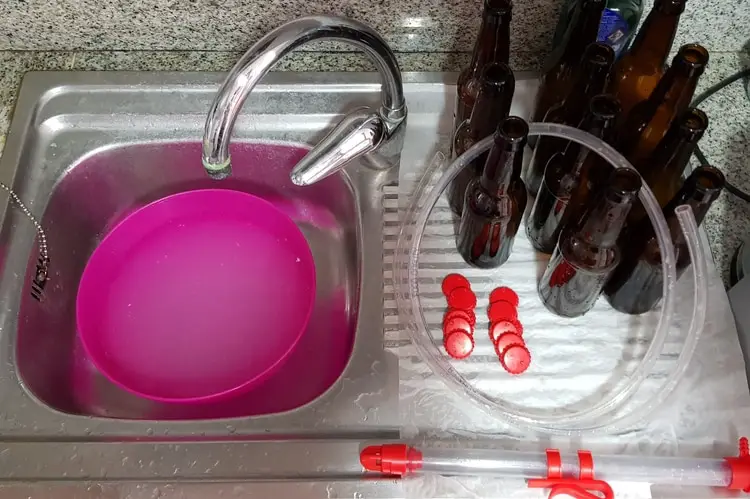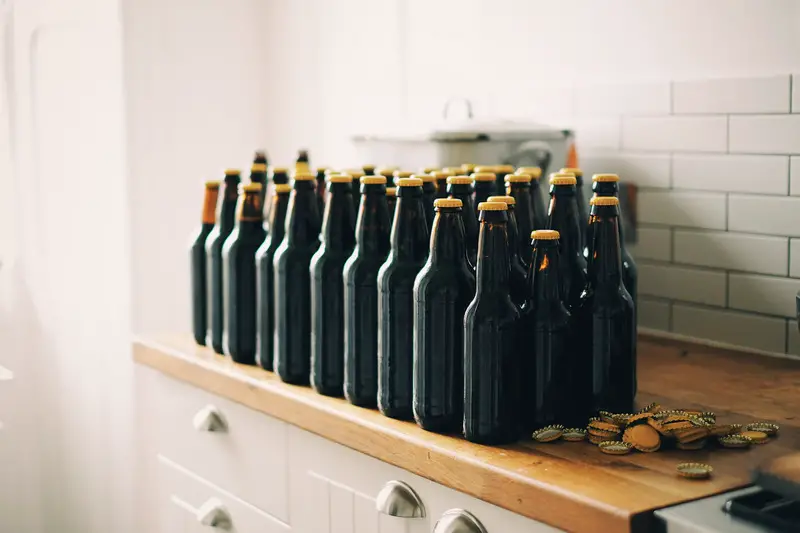Beer, like any food or beverage, does have a shelf life. If handled properly, your homebrewed creations will last many weeks and even months. Spoiled beer will not hurt you, it just tastes bad.
Homebrew and Craft-Brewed Beer stay drinkable for many weeks and even months if handled and stored properly. 60 – 90 days is a clear window to enjoy a homebrew or craft-brew. A cool storage place under 60° F / 15.5° C is ideal; 50-55° F / 10-12.7° C is even better. Mild or cool storage temperatures keep the beer stable.
Best By dates are guidelines, even marketing tools, but not hard fast rules. They indicate freshness, not spoilage.
Factors leading to spoilage or instability
- Storage temperature.
- Cleanliness of packaging.
- Yeast characteristics and quality.
- Temperature fluctuations.
- Lax brewing practices
Factor One – Proper Storage Temperature

Stable temperatures during storage are key to beer shelf-life.
The beer mellows and conditions over time, even ales- meant to be drunk young- can mature and improve over 4-6 weeks.
New England IPAs are intense, floral beers, defined by their hops. They are specifically meant to be consumed within two weeks of packaging.
The ideal cool storage temperature is 15.5° C (60° F), and 10-12.7° C (50-55° F) is even better.
The latter temperatures more closely resemble an underground cellar temperature of reputable English publicans.
Activity continues in the bottle
Maintaining a steady temperature allows the yeast to settle out, go to sleep and lie dormant.
If secondary fermentation is used, and the beer is further racked into a bottling bucket, most dead cells and fermentation detritus are left behind.
We are left with a modest number of cells which settle in the bottle, and may stabilize the flavor, not detract from it.
They will continue to absorb diacetyl and esters, fermentation by-products which in low amounts are nice, but in high amounts compromise your flavor.
Don’t awaken the yeast
Finished beer should be a sanitary, anaerobic environment.
If it is clean, a four to six month shelf life for stronger beers is realistic.
If temperature fluctuates a lot in this time, yeast could reawaken, and bottles could explode. Fermentation could reactivate and dry your beer out more than you want.
You may also get seepage around the cap, wherein the beer leaks out a bit, if improperly capped. If there are any mild contaminates, this opens a door for them to become active, and struggle with the yeast for dominance.
Bacterias could become active
There are hundreds of bacteria around us all the time and beer is not sterile, merely sanitary. There are likely some invaders, or unwanted bacteria in the beer, though in extremely small amounts.
Over months, they could begin to make their influence known. As the beer yeast goes to sleep, eventually dying off, this is the time when they may become active.
If fermented, racked, and packaged properly, the yeast will flocculate on the bottom of the bottle and be your beer’s caretaker. There will be an ever so light layer of slurry on the bottom and even should you drink from the bottle, it will not detract from your flavor.
Go for liquid yeasts
I recommend liquid yeasts which are pure cultures and hold the strongest of these caretaking characteristics.
Dry Yeast, while much improved since I started brewing in the ahem… 90’s, is much more neutral in flavor.
While it can stabilize the beer, it will not enhance its flavor profile.
Factor 2- Clean your Bottles

Is this an obvious point?
Yes and no.
Bottling can be the most tedious portion of brewing and one I would put off as long as I could.
The bottles must be scrubbed free of dirt, sanitized, and remain clean until you get beer into them.
As there could be anywhere from 50-100 bottles needed on bottling day, we get tired, maybe even a little lazy. A few bottles slip through. Homebrewers usually recycle their bottles which should be rinsed clean immediately after use. It makes life easier down the line.
Perhaps a few were not rinsed properly after drinking and some yeast dried on the bottom and we failed to scrub it out.
It happens and usually will not contaminate the whole batch.
A proper soak in sanitizer (depending on the product’s guidelines), scrub inside with a brush in sanitizing solution, followed by a hot cycle wash in the dishwasher for redundant heat sanitizing is a process which works like a charm.
One thing that does ruin the whole shooting match, however, is a dirty bottling bucket.
Buckets get scratched and form abrasions.
A bottling bucket will often have a plastic faucet attached, that coupled with a short length of hose will fill your bottle from the bottom at the perfect level every time.
Break this faucet down, scrub and soak each time you use it.
I always did this, yet I have observed others who did not, mostly due to laziness. Yellow and brown deposits collect around the rubber gasket; they should be replaced every three to six months.
Pure contaminant.
His beer was drinkable for about two weeks but after that, it soured and went south! He was a friend and I steered him in the right direction and fortunately his results improved.
Factor 3 – Yeast characteristics and quality
A good yeast, by which I mean a pure yeast strain designed and grown for a specific style, improves your beer, gives it its character, and stabilizes it for storage and aging.
A good lager yeast will just begin to reach its peak flavor in 45-60 days.
A Belgian Ale or Abbey yeast is about the same.
I strongly recommend working with liquid yeasts when you are able, as they dramatically enhance the quality of your beer.
After all, they are 25% of your core ingredients and among the other three, hops, malt and water, yeast alone delineates style more than any other.
Liquid yeasts are pure strains, meaning they are a single-species of microbe used to metabolize your sugar. They are often taken directly from commercial brewers or grown up from the same laboratories brewers buy from.
They stabilize beer, enhance flavor over time, and make it possible to brew different styles to the correct profile.
An ESB (Extra Special Bitter), Altbier, Weizen Beer, Abbey Beer, American Pale Ale are all distinct beers, each having their own unique characteristics and taste profiles.
If we simply pitch a packet of dried yeast in each one, it will not have any unique distinction past the malt and hops. This is OK for beginning brewers, but by your 5th or 6th batch, I hope you can branch out.
In the end, liquid yeast adds to your beer’s shelf life.
Factor 4 – Temperature fluctuations
Many commercial craft-brewers filter their beer, not for clarity but for stability in travel.
Yeast is not inherently unstable, nor does it detract from aged beer, but temperature fluctuation causes problems.
In most climates, except in the extreme north or south, summer brewing is to be avoided.
Unless producing Saisons or using yeast strains happy in warmer climes the beer cannot take the temperature.
It will produce over-the-top esters (fermentation aromas that add a fruitiness to the nose) and full-on phenolic blasts (molecules chemically attached to proteins which form at high temperatures leading to astringency and dryness).
Also, imagine you live in the American South, you go out of town for two weeks during a heat wave. The AC has been turned off during this time. The yeast wakes up, goes to work, and starts blowing caps off or exploding bottles. Usually our bottles are tucked away and stacked in a closet, so this is not dangerous, but it is messy and disheartening.
When you return to the reek of sour beer, you panic for a moment and discover you only lost a few bottles. Clean up and get the house cooled a bit. The rest of your beer may be OK, but this ambient fluctuation will test it, test you and your process.
If you follow all the rules, keep reasonably hyper-clean, the beer should be OK.
I lived in the American South for many years and stored beer in my closet which got up to 80° F in the summer! No, we did not have AC, we were kids. Overall, it was fine. We did consume a batch of beer in 1-2 months. It hadn’t much time to turn on us.
Factor 5 – the Proper Places – the “Cellar”
In a perfect world, you have an underground basement or a sub-basement where you can keep your beer at proper cellar temperature, 10-12.7° C (50-55° F).
No matter what the outside temp is, your temperature remains constant.
A fridge to approximate a cellar
Additionally, if you have this basement, and it resembles a rec room or has a guy fridge in it, you can store beer inside. If you want it strictly cold, fridge temp is fine, 35-40° F / 2-4° C.
However, if you want to approximate a cellar, you will have to change the thermostat on your cooler. Most fridges will not go above 40° F / 4° C.
A good refrigeration man can install one that goes up to 55° F / 12° C or so. You may do it if you are a do-it-yourselfer. In your guy fridge, you can simulate true cellar temperature.
Use the fridge to ferment lagers
A second use for such a fridge is to use it for lager fermentation.
Between 45-53° F / 7-11° C is an ideal fermentation temperature for lager beer.
To make true lagers, again a good reason to use liquid yeasts, one must utilize these cooler temperatures. Once your beer is fermented and aged, about 45 days, then you can package it.
About this topic : Top 6 Best Beer Fridges
Lagers last longer
A lager should stay good for 6-12 months, easily. There are cases when they go longer and those where they go shorter. Cool temperatures severely inhibit bacterial growth and the lager yeasts themselves thrive.
While you do not even package for 6-7 weeks, turn right back around and store the beer in the fridge for months.
It will mellow and age and depending on the other variables of your brewing process will mature.
Factor 6 – Lax Brewing Practices
Human error exists and it follows us on brewing day.
One small mistake can disrupt the trajectory of an otherwise perfect brew session.
Contamination, even one small corner of one tiny piece of hardware your finished beer touches as it’s bottled can carry the bug into your bottling bucket and beyond.
It is normal and it happens to all of us.
A quickly brewed and consumed ale, 14-21 days total, and your window for trouble is narrow.
Your yeast does its job and dominates the environment.
After this period, 4-6 weeks and beyond, the yeast is tired, what few live cells are left are happily sleeping in the bottom of your vessel.
That is when other contaminants come out, begin to work, and insidiously affect your flavor and cause the beer to turn.
Wild yeast can ferment in environments hostile to beer yeast: high alcohol, low sugar content, highly acidic (as in fruit beers).
Inside Contamination
There are also proteins and chemical compounds from the malt itself that may start to affect the flavor after say 4-6 months.
Tannins (husk compounds) and other complex carbohydrates will leach out of the beer with incorrect sparging temperatures or prolonged sparging (washing of the grain after mashing to extract sugars).
The beer can cloud, again exacerbated by unstable temperatures.
If beer does not have a proper diacetyl rest, high amounts of this buttery flavored compound can form when beer is chilled and then warmed again. A tiny bit is nice in some English ales but too much is like revisiting your childhood at the Brach’s Candy section of the local grocery.
Lastly, beer will turn when left too long in contact with oxygen. This brings oxidation. Papery flavor, a dry, stale taste, chewing on cardboard… all these things come to mind.
There will always be small amounts of dissolved O2 in beer, even at controlled levels, oxidation will occur over time. Several ways beer picks up O2.
- Splashed too much during transfer or bottling
- Too much headspace in bottles
- Yeast fails to carbonate beer
- It simply sits too long
A thorough and redundant cleaning regimen combined with proper exacting production steps are crucial to successful brewing.
The Mojo Factor
Do you have a mojo?
Does your brewing have an esoteric quality to it, in your method or your mental outlook?
Sometimes, that is what it takes to make great beer, and this beer will last indefinitely.
I had mentioned Belgian yeast before. In my experience, Belgian yeast is the hardiest, most stable yeast you can use. It also has the most complex character compared to many yeasts, in that it can add a true flavor profile to your beer, usually reserved for malt and hops.
Belgian yeast is resilient and withstands high temperatures, in fermentation and storage. A Belgian beer can easily stay fresh for 6-12 months and in most cases even mature. Try it and at the very least you will have an adventure and at best it could be one of your finest formulations.
There are Lambic (sour – spontaneously fermented beer) brewers in Belgium who age their beer in caves. In special cases, it is not released for 10 years!
A Final Word
In the summer of 2019, I was visiting the States to see my best friend, Sam. We went through the sours, the lagers, and session beers as it had been a long time since we had been together. There was one curiously unlabeled bottle in his fridge.
I pulled it out and after inquiry he confided, “You know what that is? It’s a Quadruple Bock I brewed back in 1992, just after we met.”
“You’ve carried it around all these years!?” I exclaimed, incredulously. “Well, I can’t think of a better time to try it,” we both said out loud.
The beer was a bit past its prime. However, it had a pronounced toasted finish, a hint of caramel and chocolate, a spicy hoppiness and plenty of heat from its 16% alcohol. It still tasted like beer after 27 years.
The alcohol helped preserve it. It had its flaws, sure. Sound brewing and sanitation practices as well as proper storage had preserved the beer well beyond what we may consider the reasonable life of beer. That beer had mojo.

